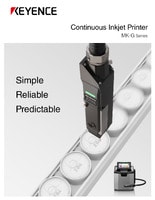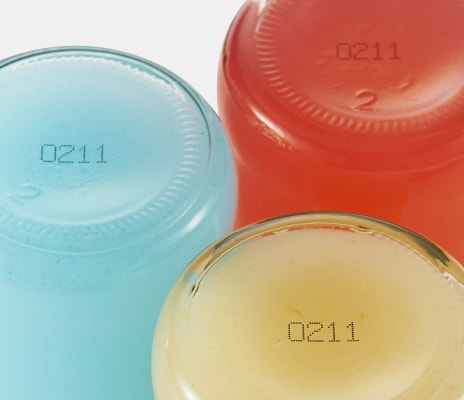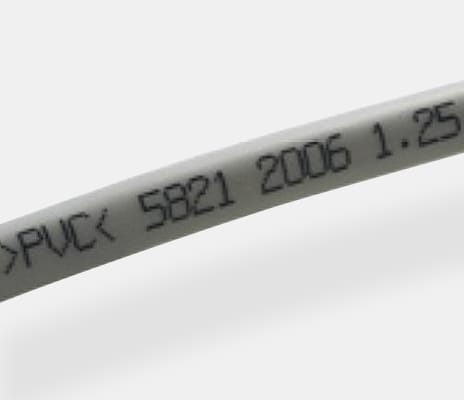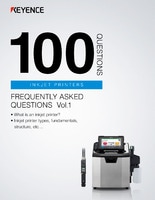Continuous Inkjet Printing
Continuous inkjet printers discharge ink to print directly on a target. This is a non-contact method that can print on any type of target without blurring, printing flaws or damaging the target.
The compact head size and the ability to print in any direction ensure easy installation in a wide range of applications from conveyors to packaging machines.
Maintenance and Troubleshooting in Continuous Inkjet Printing Technology
Maintenance and troubleshooting are inescapable aspects of continuous inkjet technology. The printers require periodic maintenance to run smoothly, as well as reactive troubleshooting when errors occur. Luckily, the MK-G Series is the world’s first self-troubleshooting CIJ continuous inkjet printer that eliminates any guesswork associated with maintenance.
Conventional

Manual cleaning
MK-G Series

The printer conducts self-diagnosis and optimal cleaning automatically


These CIJ continuous inkjet printers automatically perform maintenance and troubleshooting as needed without needing a trained technician. This includes specialized automatic cleaning of the critical printing components in the print head and an emergency shutdown in the event of a power loss.
Get detailed information on our products by downloading our catalog.
View Catalog

Operating Principles of Continuous Inkjet Printers

- Step 1: Pressurized ink is supplied to the print head from the controller.
- Step 2: Ink is fed to the nozzle which has the piezoelectric oscillator and discharge hole.
- Step 3: The ink is discharged while being oscillated by the piezoelectric oscillator, and it is simultaneously given a negative electrostatic charge. The ink is formed into an ink column, but when saturated with the negative charge, the ink becomes particles, and those particles separate from the ink column.
- Step 4: The electrostatic detection sensor monitors the ink particles to ensure they receive the appropriate electrostatic charge to prevent malfunction.
- Step 5: The ink particles that discharge from the nozzle pass between two deflecting electrodes where an electrical field is generated by a voltage of around 7000 V. At this time, a bending force acts on the ink particles according to their electrostatic charge to change the direction they travel. Synchronously, the target or print head is moved perpendicular to the ink particle travel direction to print the desired content.
- Step 6: Ink not used for printing is collected in a pipe called the gutter and reused.
We’re here to provide you with more details.
Reach out today!

Internal Structure of Continuous Inkjet Printers
This section explains the internal path and ink circulation principle of continuous inkjet printers.

Circulation path
- Solvent tank: Supplies solvent to control viscosity when the ink in the main tank becomes too thick.
- Ink tank: Supplies ink to the main tank when it is empty or when the ink is too thin.
Circulation Principle
-
1Main tank: Stores the ink used in printing. Ink recovered from the gutter is also returned here.
-
2Pump: Pressurizes and feeds the ink from the main tank to the print head.
-
3Pressure-reducing valve: Adjusts the ink pressure.
-
4Piezoelectric element: Oscillates the ink stream discharged from the nozzle to separate into ink particles.
-
5Nozzle: Discharges the ink.
-
6Electrostatic electrode plates: Applies a negative electric charge to the ink particles created from the ink stream.
-
7Electrostatic sensor: Monitors whether the ink particles have the proper electrostatic charge in them.
-
8Deflecting electrode plates: Generates a magnetic field between the electrode plates to deflect ink particles according to their charge. This directs ink particles onto the print target.
-
9Gutter: Collects the ink particles that are not used in printing.
-
10Pump: Retrieves the ink particles from the gutter and feeds them to the main tank.
Discover more about this product.
Click here to book your demo.

Continuous Inkjet Printer Applications
This method is commonly used with industrial-use printers.
Continuous inkjet printers are capable of printing on a wide variety of targets such as metals, resins, and glasses. In addition to being able to print on materials such as paper and cardboard, the quick-drying ink enables printing on materials that do not absorb ink well. Continuous inkjet printers are used in a wide range of industries such as food, medicine, cosmetics, electronics, semiconductor, automotive, and metals.
Food, Medicine, and Cosmetics
For food safety, it is necessary to accurately print manufacturing dates and best-before dates.
To prevent printing mistakes and non-printed sections, there has been an increase in the installation of inspection systems using image sensors and the implementation of similar countermeasures.

Pet bottle

Packing film

Resin bottle

Glass
Electrical and Electronic Components
The non-contact method is optimal because the parts are easily damaged by contact. Also, continuous types can print lot numbers, which is helpful in the consumer electronics industry to track a component’s manufacturing history.

LED

Dry battery

Circuit board

Capacitor
Automotive, Metal, etc.
The need for traceability is well-recognized in the automotive industry. Due to recent progress in the common use of components, this printing method is seeing increased use in applications where the printing of identification numbers is necessary to prevent assembly errors.

Aluminum material

Wood

Metal component

Cable
Curious about our pricing?
Click here to find out more.

FAQs
What Is a Continuous Inkjet?
Continuous inkjet printing is a noncontact, versatile, and high-speed way to print lot codes and date codes on substrates along a manufacturing line. In a CIJ continuous inkjet printer, ink is propelled from a reservoir through a nozzle. As it passes through the nozzle, the ink undergoes fragmentation, breaking down into countless tiny droplets. This fragmentation process is achieved by utilizing high-frequency vibration.
As the stream of droplets flows, it encounters deflector plates that generate an electrostatic field. This is where the magic unfolds - the charged drops gracefully deflect as they pass through the plates. This meticulous process ensures a steady and accurate stream of minuscule droplets, ready to be accurately directed onto the desired product. Droplets that haven’t been electrically charged are recirculated back into the system for reuse, hence the name "continuous inkjet printing."
What Are the Advantages of Continuous Inkjet Technology?
There are numerous benefits associated with continuous ink technology. For example, continuous inkjet printers are known for their high-speed printing capabilities without sacrificing quality, which makes them ideal for fast-moving production lines. The printhead doesn’t make contact with the substrate during printing, which is important for printing on curved or uneven surfaces. Furthermore, CIJs use quick-drying inks allowing for excellent adhesion.
What Are the Uses of Industrial Continuous Inkjet Printers?
Continuous inkjet printers are favored in numerous applications for their ability to print at high speeds, with great precision, and on various substrates. Though they’re mostly used to print lot codes, date codes, and bar codes across various industries, CIJ technology is extremely versatile and can be used in a wide array of applications.
A few common examples of continuous inkjet printing applications would be date/lot codes on meat and dairy products (think of the best-by on your milk), beverages/bottles/cans, cable/pipe/wire, pharmaceutical/cosmetics products/packaging, and anything that needs a quick best-by date or lot code.
How Are Industrial CIJ Printers Different from Normal Printers?
CIJ printers, also known as continuous inkjet printers, differ significantly from typical desktop inkjets in several different ways. CIJ printers rely on a continuous stream of ink droplets, which are charged and then directed onto the substrate using an electric field. The droplets that aren’t used are just recirculated back through the system. They’re designed to work at very high speeds, often ranging from 200 ft to 1000 ft of print per minute, and are capable of printing on almost any surface, using specialized solvent- or water-based ink.
In contrast, desktop inkjets and laser printers used in residential and office applications typically deposit tiny ink droplets directly onto the paper or use a toner and heat. Additionally, they’re mainly designed to print documents for home and office use, so speed isn’t a primary factor, and they’re mostly limited to printing on paper and photo paper. Also, the ink is designed for paper, and it’s either dye- or pigment-based.
Are There Different Types of CIJ Printers Available, and How Do I Choose a CIJ Printer for My Needs?
Yes, there are different types of CIJ printers and CIJ printing technology available on the current market, and each is designed with specific industrial printing applications in mind. The most important thing to consider is the printing surface or substrate you’re going to be printing on. While CIJ printers are, indeed, incredibly versatile when it comes to substrate selection, the truth is that different models are more optimized for particular substrates. So, it’s crucial to choose a CIJ printer that’s compatible with the substrate you’re printing on.
What Is the Difference Between TIJ and CIJ Printers?
Discussing their similarities would make a shorter list. The actual ink expulsion works differently in both types. As discussed above, CIJ relies on the continuous ink flow, while the TIJ uses a resistor to heat the ink so it bubbles onto the target substrate.
Of course, this implies different ink types, with TIJ using water-soluble ink, which is quite limiting in terms of printing substrates, mostly paper and similar materials. However, they offer higher-resolution prints, which makes them perfect for applications that demand more detailed graphics or small and precise text.
CIJ printers, on the other hand, are more versatile in terms of substrates, and they use solvent-based ink that has better adhesion to a wider array of materials. However, the resolution is generally lower than that on TIJ printers, as CIJs are more focused on speed and versatility rather than level of detail.
What Is CIJ Printing Technology?
As its name implies, continuous inkjet printing technology relies on the continuous flow of ink to produce images. The CIJ printer pushes the ink through a very, very small nozzle under high pressure, which creates the ink stream. As the droplets of ink form, they pass through an electrostatic field, which imparts electrical charge to the drops. Droplets are formed and then given a charge. They continue through a set of plates known as deflector plates that form an electromagnetic field. This field redirects only the charged droplets onto the substrate to form text. The uncharged drops are recirculated back through the printer, making CIJ printers very resource-efficient.
Related Downloads

This is a technical guide describing basic knowledge of continuous inkjet (CIJ) printers from mechanisms such as the types, printing fundamentals, and internal structure, to running costs and legal compliance. Subsequent issues will also be available. By reading all of these issues, you can understand the entire overview of continuous inkjet (CIJ) printers.


